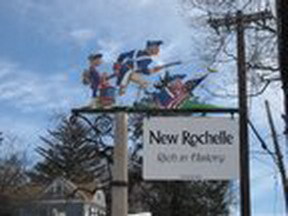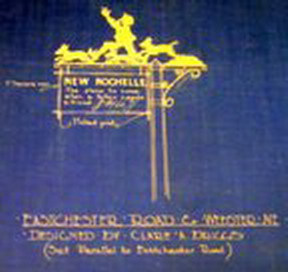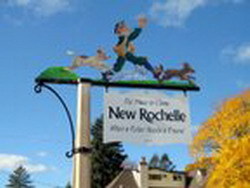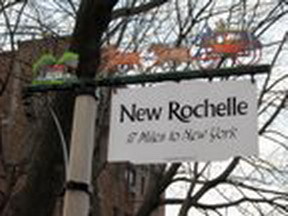New Rochelle, NY offers its residents the best of all words – a historic city with a vibrant downtown and classically handsome architecture situated just two miles north of NYC’s limits. However, the thriving city had neglected to sufficiently refurbish its octogenarian signage that had rusted from within to the point where it no longer handled signs’ primary task – to positively reinforce the image of, and attract business to, municipalities, retailers, service providers and others. Several local signmakers and sympathetic civic organization helped revitalize the signs to their yesteryear glory.
The back story
Founded in 1688 by French Huguenots fleeing religious persecution, New Rochelle’s name derives from the abundance of settlers from La Rochelle, France. However, the settlers quickly assimilated to their predominantly English-speaking neighbors. During the mid-19th Century, the then-agrarian town gained a stop along the New York and New Haven railway. Subsequently, city dwellers emigrating north, and those newcomers who wished to settle near, but not in, the city helped gradually swell the town’s population to the 72,000-plus inhabitants cited in the 2000 Census.
In 1922, city fathers capitalized on the burg’s vibrant culture and commissioned several prominent artists living in the town (among them Norman Rockwell) to design a 10-sign, gateway program that adorns its borders with Pelham, Larchmont, Eastchester and Scarsdale. A local steel foundry, Fieberger & Sons, fabricated the signage and motifs. According to Joseph Lanza, a New Rochelle resident, proprietor of Port Chester, NY-based SignDesign & JC Awning and a second-generation sign fabricator, Rockwell made quite an impression when he visited the foundry.
Advertisement
“According to the grandson of the foundry’s then-owner, Rockwell stepped out of a new Packard in an expensive suit, kneeled on the dirty shop floor and outlined his work on a piece of cardboard,” he said. “When it was finished, the whole shop celebrated their achievement by passing around bottles of wine.”
Given the arduous fabrication process, ample cause existed to celebrate. In that era, constructing custom, steel artwork required the forging of several uniquely shaped chisels to cut ¼-in. and ½-in.-thick steel. Moreover, each sign weighed 200 to 300 lbs. Scenes depicted on the signage included the Huguenots’ settlement of the area, Lord Howe and the British Redcoats passing through the area in 1776, and a horse-drawn carriage atop a placard that reads, “17 Miles to New York City.”
Restoring the glory
Over the years, the signs received periodic new coats of paint – however, these did nothing to slow the structural degradation. Two years ago, Mickie Fosina, wife of former city councilman Joe Fosina, initiated a movement to repair and renovate the sign program. Subsequently, the New Rochelle Sign Restoration Committee, of which Lanza is a member, formed. The group raised $85,000 to cover reconstruction costs that Lanza said would have commanded $200,000 had public funds been appropriated.
Simply put, the signs were rusting from the inside out. Lanza’s company produced much of the work and enlisted specialists to provide key services. Utica (NY) Cast Stone, a 100-plus-year-old, architectural-stone casting company, which duplicated the unique posts. Pattie’s Portico, a local powdercoater, sandblasted away layers of rust, and Tait Electric helped construct the foundations and develop the signs’ accent lighting.
Advertisement
After the rust removal, Lanza’s shop made metal repairs, primed the signfaces with an electrostatic coating – which enhanced their durability considerably – and powdercoated them a bright, white palette that create a bright tableau for recreating the original scenes.
“Our goal was to recreate motifs that would withstand any weather conditions,” Lanza said. “To paint the scenes, we chose 1Shot® lettering enamels because of their brightness and durability.”
In addition to the signs’ weakened physical condition, logistical hurdles also loomed. After removing the original, 1,800-lb., cement footings, Lanza faced updated sign codes, which required the pouring of a 4 x 4 x 6-ft. foundation to support the signs. Also, some original sign locations weren’t feasible because utility poles and buildings had encroached into the required footprint. Six of the 10 original signs had to be moved from their original locations, but suitable space was found nearby in each case.
The restoration committee attempted to solicit local artists, but received little response. Undaunted, Lanza contacted Brec Morgan, who’d operated Norwalk, CT-based Morgan Signs prior to retirement. “I admired his work and knew his skill would create signs that would read well and look great from 50 to 100 ft. away,” he said.
Advertisement
All told, the project took approximately two years and was completed earlier this year. New Rochelle Mayor Noah Bramson and other city officials praised the committee’s work, but residents and visitors provided the most decisive approval by honking their horns when passing and shouting congratulations to the crew. Now, the project is complete except for Con-Edison’s final electrical hookup.
“This is one time that signage took on a life of its own for the betterment of the entire city,” Lanza said. “This is a project that our children will still be proud of.”
Anyone wishing to make a tax-deductible contribution to help defray outstanding expenses may write to: The New Rochelle Sign Restoration Committee, P.O. Box 1243, New Rochelle, NY 10802.



 Tip Sheet4 days ago
Tip Sheet4 days ago
 Business Management2 weeks ago
Business Management2 weeks ago
 Real Deal5 days ago
Real Deal5 days ago
 Women in Signs2 weeks ago
Women in Signs2 weeks ago
 Benchmarks2 days ago
Benchmarks2 days ago
 Editor's Note1 week ago
Editor's Note1 week ago
 Women in Signs5 days ago
Women in Signs5 days ago
 Line Time2 weeks ago
Line Time2 weeks ago














